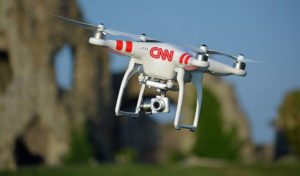with Deb Halpern Wenger
 Drones have already proved their worth in national and international news coverage, adding fresh perspective to reports on natural disasters and environmental issues. Now, drones are being used more widely by local news organizations, and DJI‘s Jon Resnick says it’s a no-brainer to get in the game.
Drones have already proved their worth in national and international news coverage, adding fresh perspective to reports on natural disasters and environmental issues. Now, drones are being used more widely by local news organizations, and DJI‘s Jon Resnick says it’s a no-brainer to get in the game.
“[Drones] let us tell stories more effectively, more economically, and more quickly, Resnick says. “And everyone benefits from that, the audience and the news entity, and we create a whole new way of looking at our world.”
Resnick spent almost 20 years as a news producer and editor, most recently with the Associated Press. He says his eyes were opened to the potential of drones after his experience with Hurricane Sandy. “I had all my people perfectly positioned in New Jersey, prearranged for aircraft to get aerials afterward,” Resnick says. “All of a sudden all of those airplanes and helicopters, they either were broken to pieces, didn’t have access to fuel or their pilot was trying to save their own house. So it took me hours and hours to get aerials.”
A few months later, a DJI Phantom drone was featured at the Consumer Electronics Show. “I said, ‘Holy cow, I could put one of those in every reporter’s car.’ It costs like $1,000. That was nothing in our business. What if every reporter had one of these? [A reporter] would have popped the drone up, gotten to a hundred feet and had incredible aerials of the devastation within a half hour he would have had it fed back to the mother ship and it would have gone out all over the world and at a fraction of the cost of what aerials cost.”
Resnick expects tremendous growth in the use of drones by local TV stations, especially in medium and small markets, where a lot of airspace is unrestricted. “All of a sudden your storytelling is dramatically improved because you have access to capabilities that you just could not afford before,” he says. “Whether you talk about cranes or jibs or dollies and tracking, all of these all of a sudden are in your hands now, and you can do it in minutes as opposed to hauling in tons of equipment, having extra personnel.”
If you want to use a drone to shoot news video as a professional, you need a special pilot’s license known as a Part 107. Thanks to a partnership involving the Poynter Institute, the Drone Journalism Lab at the University of Nebraska-Lincoln, National Press Photographers Association and the drone manufacturer DJI, journalists can learn how to pass the test at a three-day drone journalism camp being offered across the United States.
Resnick urges newsrooms to adopt clear guidelines and operating procedures for drones, and to explain what they’re doing and why to public safety and elected officials in their communities. The editor of the Virginian-Pilot, for example, wrote a column to introduce the paper’s new drone photographer.
Newsrooms and journalism educators are already using drones for newsgathering. At the University of Mississippi, instructor Ji Hoon Heo is a certified drone pilot. He’s helping students develop story ideas that lend themselves to the use of drones. Heo has developed three essentials for using drones for news.
Planning is key. Heo now requires reporters to have a shot description or a storyboard of the shots they think they will need for their stories. He created a video to demonstrate the different types of shots they might consider.
Use the team approach. Heo says it helps to have a drone operator, an observer and a journalist. The drone operator has the technical know-how, the observer makes sure that the drone is safe, and that allows the journalist to focus on covering the story. (If three people are out of the question, Heo says it can be done with the two.)
Shoot more than you think you’ll need. The young journalists Heo works with typically stop recording too early. Every shot should be at least 10 seconds long and more is better.
Whether it’s a hard news piece about a protest or a feature about the prettiest college campus, Heo focuses on using drone footage when there’s a reason for it, rather than using it as a gimmick. Resnick agrees. “The last thing I want are stories that use drones to be stories about using drones.”
https://youtu.be/dro35g70FaI








